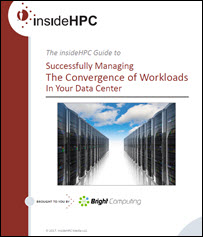We continue our insideHPC series of features exploring new resource management solutions for workload convergence, such as Bright Cluster Manager by Bright Computing. This article focuses on how forming server clusters and utilizing cloud computing can help your enterprise achieve more flexibility and speed.

Download the full report.
Clusters for Faster Results
For applications that are highly scalable, utilizing the CPU cores or the accelerator cores may not be enough. That’s when the IT department may deploy a cluster. By clustering a number of these servers, hundreds of CPU cores and thousands of accelerator cores can be accessed by the same application. The application must be designed, though, to recognize that these are different servers running independent operating systems. Applications that run on a single OS can take advantage of certain APIs and compiler options to run over the cores and share the memory. But when the application needs to keep track of different parts of the code running on an entirely independent server, an added layer of understanding of the algorithms and programming to a communication API is required.
Applications that can run entirely on a single server, for example, may let the compilers determine areas of parallelization using OpenMP directives.
Applications that can run entirely on a single server, for example, may let the compilers determine areas of parallelization using OpenMP directives. Once the application can scale outside of a single server, it can use the Message Passing Interface (MPI) API. In highly parallel applications, MPI can be used to distribute the work to the different servers within the clusters, but the application must also use OpenMP for the code that is running on the server. Understanding which applications require which APIs and on which systems can significantly increase the overall performance of a set of applications, thus producing faster results.
Cloud Computing Delivers Flexibility and Speed
Cloud computing provides an enterprise both flexibility and speed, thereby helping it be more responsive to the needs of its users. While inhouse data centers are usually designed with a predetermined capacity, growing businesses cannot always determine future peak capacity. And changing workloads, often due to acquisition processes or product development deadlines, challenge that capacity. It’s rarely feasible to quickly acquire and then shed servers, networking, and storage.
[clickToTweet tweet=”Cloud computing provides an enterprise both flexibility and speed, helping it be more responsive. #HPC” quote=”Cloud computing provides an enterprise both flexibility and speed, helping it be more responsive to its users. #HPC”]
Further, while in-house clusters may perform well for expected workloads, when these workloads exceed the available compute or storage capacity, work on a project may come to a complete halt. An even greater and time-consuming expense is when a data center is physically full or has run out of power and/or cooling capacity.
Cloud computing providers allow enterprises to expand and contract necessary computing resources, even on short notice. Some organizations may need additional computing power for only a few hours to satisfy a brief increase in workload, while others may need additional capacity for an indefinite period. When more capacity is needed, automated tools quickly acquire and provision new servers. When less capacity is needed, these same automated tools release the excess resources, thus reducing costs.

Public clouds typically have the latest and highest-performing servers that may provide results faster than in-house data centers.
In some cases, an additional benefit of cloud computing is speed: public clouds typically have the latest and highest-performing servers that may provide results faster than in-house data centers.
Such agility is critical in today’s business world, as successful enterprises must be able to quickly change the product mix based on customer desires as well as capitalize on predicted trends. Pursuing these new products often requires a new set or mix of computing and storage technologies.
Successfully managing an in-house cluster or a cluster that resides at a cloud provider requires tools that can simply and efficiently regulate capacity. Bright Cluster Manager excels at providing these tools, thereby making organizations more agile in responding to workloads at any given time.
The insideHPC Special Report on scheduling solutions for easier workload convergence in data centers will also cover the following topics over the next few weeks:
-
Successfully Managing Workload Convergence in Your Data Center
- The Three Types of Clouds
-
Scheduling to Optimize Infrastructure
-
Resource Management Across the Private/Public Divide
Download the full report, “insideHPC Special Report: Successfully Managing The Convergence of Workloads In Your Data Center,” courtesy of Bright Computing.



